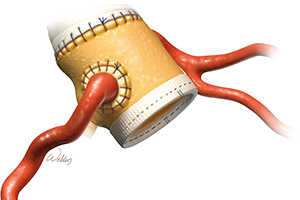Transcatheter valve-in-valve implantation for degenerated stentless aortic bioroots
Abstract
Background: Open surgical repair of a failed valve-sparing aortic root replacement (VSARR) or stentless bioroot aortic root replacement (bio-ARR) entails significant operative risks. Whether valve-in-valve transcatheter aortic valve replacement (ViV-TAVR) is feasible in patients with a previous VSARR or stentless bio-ARR remains unclear, given lingering concerns about the ill-defined aortic annulus in these patients and the potential for coronary obstruction. We present our experience with patients who had a previous VSARR or stentless bio-ARR and underwent ViV-TAVR to repair a degenerated aortic valve with combined valvular disease, aortic insufficiency and aortic stenosis.
Methods: In this retrospective data review, we identified and analyzed consecutive patients with a previous VSARR or stentless bio-ARR who underwent ViV-TAVR between December 1, 2014 and August 31, 2019.
Results: ViV-TAVR was performed in twelve high-risk patients with previous VSARR or bio-ARR during the study period. Of these, seven received Medtronic Freestyle porcine stentless bioprosthetic aortic roots, three received homograft aortic roots, one underwent a Ross procedure and one underwent VSARR. ViV-TAVR restored satisfactory valve function in all patients, and technical success was 100%. No patient had more than mild regurgitation after implantation. No thirty-day mortality was seen. One patient had major bleeding after transapical access, one patient had a transient ischemic stroke, and one patient needed permanent pacemaker implantation. At a median last follow-up of 21.5 months (interquartile range, 9.0–69.0 months), all patients remained alive and had satisfactory valve function.
Conclusions: In this study, ViV-TAVR was a clinically effective option for treating patients with a failed stentless bio-ARR or previous VSARR. Short-term and intermediate-term results after these procedures were favorable. These findings may have important implications for treating high-risk patients with structural aortic root deterioration and call for better transcatheter heart valves that are suitable for treating aortic insufficiency.
Cover






